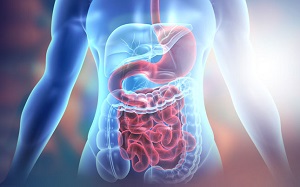Trust Your Gut: Establishing Confidence in Gastrointestinal Models
An Overview of the State of the Science and Contexts of Use
Webinar Series & Workshop
Webinar Series:
- Webinar 1 – Absorption and Pharmacokinetics: September 18, 2023
- Webinar 2 – Microbiome Effects on Toxicity: September 20, 2023
- Webinar 3 – Evaluating Potential Allergenicity: October 6, 2023
Workshop: October 11-12, 2023
Porter Neuroscience Research Center, National Institutes of Health, Bethesda, MD
Slides and video for all webinars and the workshop are available below. A report from the workshop (Debad et al. 2024) was published in ALTEX.
One of the most common chemical exposure routes is via the gastrointestinal tract (GIT). Orally administered substances are first metabolized by the GIT, and both parent substance and any formed metabolites have the potential to be absorbed through the GIT. During these processes, either or both may damage the GIT. Since toxicity in the GIT can result in systemic toxicity, screening of potential toxicants could provide an efficient way to identify potential systemic toxicants. Even in the absence of toxicity, understanding GIT absorption provides insight into systemic exposure levels that inform the potential for toxicity in other target organs.
While in vivo rodent studies have historically been used for understanding GIT absorption and toxicity, animal models have well-documented anatomical, physiological, and biochemical differences from humans. Mammalian cell culture methods of varying complexity can be used in a variety of applications including rapid response, metabolism/metabolite secretion, and microbiome studies, and generating data for pharmacokinetic modeling. Accordingly, NICEATM, NIEHS, FDA, EPA, CPSC, DoD, the Johns Hopkins Center for Alternatives to Animal Testing, and Unilever organized this workshop on the state of the science for using NAMs to predict GIT absorption and toxicity. A series of three preliminary webinars introduced the three principal topics of the workshop:
- De-risking systemic toxicity, understanding absorption/pharmacokinetics;
- Gastrointestinal toxicity; and
- Evaluating potential allergenicity.
These preliminary webinars laid the foundation for the subsequent in-person workshop where speakers from academia, industry, and regulatory bodies explored the state of the science for absorption and metabolism models, integrating the microbiome, and GIT toxicity models.
Webinar and Workshop Slides
Webinar 1 Slides
- Development of NAMs for Decision-making
Maureen Gwinn, EPA Office of Research and Development - The Importance of Identifying Regulatory Gaps Prior to Tool Development
Steven Musser, FDA Center for Food Safety and Applied Nutrition
Webinar 2 Slides
- The Gut as a Target Organ and Barrier: Challenges and Opportunities for NAMs in Chemical Risk Assessment
George Kass, European Food Safety Administration - NAMs as Tools for Mechanistic Understanding of Gastrointestinal Tract Toxicity
Jose Vincente Tarazona, Spanish National Environmental Health Centre
Webinar 3 Slides
- The Induction of Allergen-specific Antibodies in Allergy and Oral Tolerance
Sarita Patel, Massachusetts General Hospital/Harvard Medical School - Food Antigen Transport Across the Intestinal Epithelium
Simon Hogan, University of Michigan
Workshop Slides
- Evaluation of Human Intestinal Epithelium in MPS Platform as an In Vitro Model for Drug Absorption
Ye Eun Jeong, FDA Center for Drug Evaluation and Research - Evaluating the Technical Quality of a Triculture Gut Model to Test Particle Permeability
Elijah Petersen, National Institute of Standards and Technology - Using Caco-2 Permeability to Estimate Oral Bioavailability for Environmental Chemicals
Elaina Kenyon, EPA Office of Research and Development Center for Computational Toxicology and Exposure - Biopsy-derived Human Intestine-chips to Investigate Region-specific Barrier Responses
Ville Kujala, Emulate, Inc. - Development and Implementation of Human Intestinal Organoid Models for GI Toxicity
Julia Co, Genentech - Characterization of a Human In Vitro Intestinal Model for the Hazard Assessment of Engineered Nanomaterials
Christie Sayes, Baylor University - Estimation of Oral Bioavailability for Environmental Chemicals
John Wambaugh, EPA Office of Research and Development Center for Computational Toxicology and Exposure - A Three-layer Intestinal Model for Toxin Translocation Studies
Kristin Gilchrist and Angela Melton-Celsa, Uniformed Services University - The Development of a 96-well Plate-based Model of the Human Intestinal Epithelium with Applications for Modeling Toxicity and Pharmacokinetics
Bill Thelin, Altis Biosystems - Human Stem-cell Derived Intestinal Organoids as a Tool to Evaluate Human Exposure and Presystemic Metabolism
Patrick Lundquist, Uppsala University - Accelerating Synthetic Biotic Development with Gut-on-a-chip Technology
Tyler Nelson, U.S. Air Force 711th Human Performance Wing - Gastrointestinal Toxicity in Model Animal Species Using Organ Tissue Equivalents
Colin Bishop, Wake Forest University


